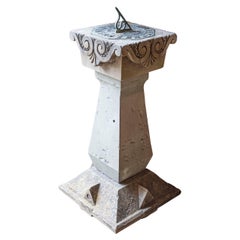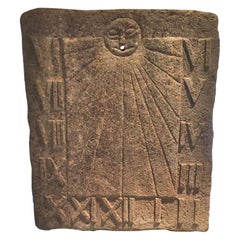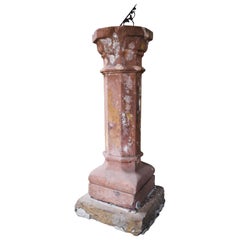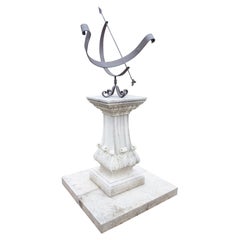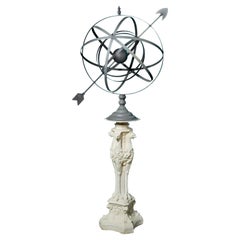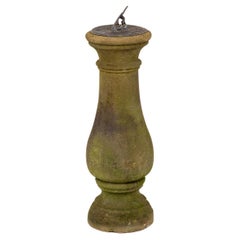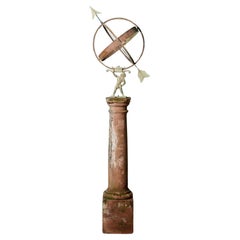Sandstone Sundials
to
2
1
3
Height
to
Width
to
1
1
2
767
70
37
33
17
3
2
1
1
1
3
3
3
Material: Sandstone
English Late 19th Century Sundial with Carved Limestone and Bronze Top
Located in Atlanta, GA
An English sundial from the late 19th century, with carved limestone and bronze top. This English sundial features an obelisk-shaped base, raised on a pyramidal plinth, with cut-off ...
Category
Late 19th Century English Antique Sandstone Sundials
Materials
Sandstone, Bronze
18th Century French Stone Sundial
Located in Vosselaar, BE
A impressive late 18th century French sandstone sundial mounted on a custom lade iron stand. The Latin numerals finely carved at both sides an...
Category
Late 18th Century French Neoclassical Antique Sandstone Sundials
Materials
Sandstone
Scottish Sundial
Located in Bloomfield Hills, MI
An eternally functioning timepiece, this 19th century Scottish sundial adds a bold statement to every environment. Atop a grand sandstone pillar, thi...
Category
19th Century Scottish Antique Sandstone Sundials
Materials
Sandstone
$10,175
Related Items
Large Italian Limestone Garden Armillary Sundial with Acanthus Carvings
Located in Dallas, TX
More information coming soon…
Measuring almost seven feet tall, this towering armillary sundial would make a wonderful garden ornament. Hand-carved in Italy, the tall base, which i...
Category
21st Century and Contemporary Italian Sandstone Sundials
Materials
Stone, Limestone, Metal, Iron
$7,900
H 83.25 in W 39.375 in D 39.125 in
Large Armillary Sundial with Cast Iron Pedestal
Located in Wormelow, Herefordshire
Large Armillary Sundial with cast iron pedestal. A Victorian white painted, Cast Iron sundial pedestal. The column is cast with four eagles and leave...
Category
Late 19th Century Antique Sandstone Sundials
Materials
Steel, Iron
Small 18th Century French Carved Stone Baroque Head Of A Saint
Located in Buisson, FR
Lovely small carved stone head of a Saint with a great expression.
France, circa 1750. Weathered. measurements include the wooden base
H:20cm W:8,5cm D:10,5cm
Category
18th Century French Baroque Antique Sandstone Sundials
Materials
Stone
$348 Sale Price
48% Off
H 7.88 in W 3.35 in D 4.14 in
18th Century Italian Carved Figure
Located in Los Angeles, CA
From a beautiful home in Santa Barbara. Not sure if paint is original, but it is definitely old. Finely carved with a lot of character.
Category
18th Century Italian Neoclassical Antique Sandstone Sundials
Materials
Wood, Paint
Italian 18th Century Chalk/ Cast Stone Angel Head
Located in Buisson, FR
Wonderful chalk/ cast stone angel head.
Italy circa 1750
Weathered, small losses.
Measurements include the wooden base.
H:20cm W:11cm D:10cm
Category
18th Century Italian Baroque Antique Sandstone Sundials
Materials
Stone
$584 Sale Price
43% Off
H 7.88 in W 4.34 in D 3.94 in
18th–19th Century Spanish Carved Stone Lion’s Head Wall Element
Located in Bonita Springs, FL
18th–19th Century Spanish Carved Stone Lion’s Head Wall Element
A powerful and expressive sculptural fragment depicting a lion’s head, originally part of a grand architectural ensemb...
Category
19th Century Spanish Neoclassical Antique Sandstone Sundials
Materials
Stone, Metal
Antique 18th Century George II Limestone Sundial
Located in Wormelow, Herefordshire
An antique mid 18th century George II limestone sundial with a bronze sundial plate. Dating to circa 1750, this striking English sundial showcases an unusual bulbous shape on an impr...
Category
Mid-18th Century English Georgian Antique Sandstone Sundials
Materials
Stone, Limestone, Metal, Bronze
French 18th Century Neoclassical Hand Carved Oak Caryatid Angel Figure
Located in Buisson, FR
Wonderful period piece. Beautiful weathered Neoclassical hand carved oak caryatid angel figure.
Weathered. france circa 1780
H:34,5cm W:10cm D:5,5cm
Category
18th Century French Neoclassical Antique Sandstone Sundials
Materials
Oak
$501 Sale Price
46% Off
H 13.59 in W 3.94 in D 1.97 in
Pair of 18th Century French Limestone Lions
Located in Los Angeles, CA
A magnificent pair of 18th century French Hand Carved Limestone Lions. The base measurement is 11.5 inches.
Category
18th Century and Earlier French Antique Sandstone Sundials
Materials
Limestone
French, 18th Century Carved Stone Head Fragment
Located in Buisson, FR
Magnificent carved stone head fragment with a very beautiful and strong expression.
France, circa 1750.
Beautiful weathered and small losses.
Measurement is with the wooden base.
H:3...
Category
18th Century French Baroque Antique Sandstone Sundials
Materials
Stone
$1,150 Sale Price
48% Off
H 12.6 in W 7.88 in D 5.52 in
Vintage Cast & Carved Stone Spanish Garden Sundial
Located in Port Jervis, NY
Fabulous large Unusual form cast & carved stone Spanish Garden sundial. Cast and imprinted with its makers name & date (1938), this will enhance all gardens that it graces. Roman num...
Category
1970s American Greco Roman Vintage Sandstone Sundials
Materials
Cast Stone, Iron
Vintage English Country Green Cast Iron Hummingbird and Dragonfly Garden Sundial
Located in Elkhart, IN
A beautiful and charming vintage English Country style green cast iron garden sundial with Roman numerals, featuring a dragonfly and hummingbird resting on a leaf.
USA, Late 20th Ce...
Category
Late 20th Century American Country Sandstone Sundials
Materials
Iron
$695
H 1.75 in W 8 in D 7 in
Previously Available Items
Victorian Sandstone Sundial
Located in Faversham, GB
A superb weathered Victorian sandstone sundial of baluster form with a molded circular base.
The top has a circular lead dial with Roman numerals and sun detailing to the face and a...
Category
Late 19th Century British High Victorian Antique Sandstone Sundials
Materials
Sandstone, Lead
Antique Georgian Style Armillary Garden Sundial
Located in Wormelow, Herefordshire
A striking antique Georgian style armillary sundial featuring an unusual 20th century armillary sphere mounted upon a beautifully weathered Georgian era red sandstone column plinth.
...
Category
19th Century English Georgian Antique Sandstone Sundials
Materials
Sandstone, Steel
Georgian Carved Stone Sundial
Located in Wormelow, Herefordshire
An elegant Georgian carved Sandstone Baluster shaped sundial with a slate sundial plate, signed ‘Negretti & Zambra London’. This is made from slate with a Bronze gnomon. The state has been cracked in the past by the corrosion and expansion of an old fixing. It has been repaired. The Sundial...
Category
Late 18th Century Antique Sandstone Sundials
Materials
Slate, Sandstone
Early 20th Century Edwardian Bronze and Sandstone Garden Armillary
Located in Essex, MA
Large early 20th century armillary. Carved sandstone base in neoclassical form with laurel wreaths. Bronze armillary with arrow and hippocampus.
Category
Early 20th Century English Neoclassical Sandstone Sundials
Materials
Sandstone, Bronze
12th Century Sandstone Zodiac Sundial
Located in Vosselaar, BE
A impressive and intriguing Spanish Zodiac dating back to the Romanesque period. This architectural fragment would originally have been part of the facade of a aristocratic house or the inner walls of a cloister. Knowledge of the Zodiac was the privilege of the upper classes and only kept alive trough the efforts of monks who safeguarded (and hid at the same time) books and manuscripts since antiquity.
This example is very rare, not only because of its age and size but also because it combines a Zodiac with a sundial. It is executed with great care and eye for proportion.
The sculpture was originally made out of two vertical slabs tightly positioned next each other. We fixed both stones together and finished with a natural mortar in between as they did in the 12th century...
Category
15th Century and Earlier Spanish Medieval Antique Sandstone Sundials
Materials
Sandstone
12th Century Stone Zodiac Sundial
Located in Vosselaar, BE
A impressive and intriguing Spanish Zodiac dating back to the Romanesque period. This architectural fragment would originally have been part of the facade of a aristocratic house or the inner walls of a cloister. Knowledge of the Zodiac was the privilege of the upper classes and only kept alive trough the efforts of monks who safeguarded (and hid at the same time) books and manuscripts since antiquity.
This example is verry rare, not only because of its age and size but also because it combines a Zodiac with a sundial. It is executed with great care and eye for proportion.
The sculpture was originally made out of two vertical slabs tightly positioned next each other. We fixed both stones together and finished with a natural mortar in between as they did in the 12th century...
Category
15th Century and Earlier Spanish Medieval Antique Sandstone Sundials
Materials
Sandstone
Carved Stone Sundial with Scalloped Edge
Located in Katonah, NY
A carved stone baluster, the top with reverse scalloped edge, surmounted by bronze sundial plate, English, circa 1870. Measure: 40 ins. high over...
Category
19th Century English Neoclassical Antique Sandstone Sundials
Materials
Sandstone
English Sundial with Scalloped Edge
Located in Katonah, NY
A carved stone baluster, the top with reverse scalloped edge, surmounted by bronze sundial plate, English, circa 1870. Measure: 40 ins. high over...
Category
19th Century English Neoclassical Antique Sandstone Sundials
Materials
Sandstone
English 1860s Baluster-Shaped Sandstone Sundial with Verdigris Bronze Dial
Located in Atlanta, GA
An English sandstone baluster-shaped sundial with bronze dial from the mid 19th century. This English sundial features a lovely baluster shape, topped with a bronze dial revealing a ...
Category
Mid-19th Century English Antique Sandstone Sundials
Materials
Sandstone, Bronze
Recently Viewed
View AllMore Ways To Browse
Cannon Sundial
Sundial Clock
Antique Cast Iron Sundial
Lead Sundial
Antique Sun Dial
Antique Armillary Sphere Sundial
Antique Stone Pedestal With Sundial
Bronze Garden Sun Dial
Middle Eastern Dress
Milo Baughman Olivewood
Neil Walling
Quilted Mahogany
Religious Art Panels
Round Table Wine
Santa Maria Del Fiore
School Of Fish Metal Sculpture
Steeple Chase
Swedish Air
